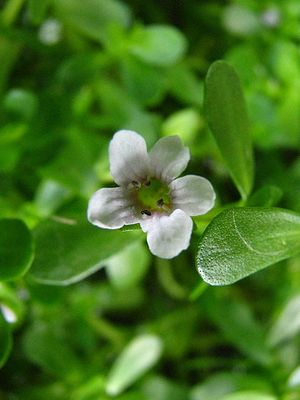Note: This is a project under development. The articles on this wiki are just being initiated and broadly incomplete. You can Help creating new pages.
Difference between revisions of "Bacopa monnieri - Brahmi"
(→Leaf) |
(→Flower) |
||
| Line 26: | Line 26: | ||
===Flower=== | ===Flower=== | ||
| − | {{Flower|Unisexual| | + | {{Flower|Unisexual||white-purplish|five petals|Brahmi flowers bloom in most months of the year}} |
===Fruit=== | ===Fruit=== | ||
Revision as of 12:16, 16 April 2018
It is a non-aromatic herb. The leaves of this plant are succulent, oblong and 4–6 mm (0.16–0.24 in) thick. Leaves are oblanceolate and are arranged oppositely on the stem. The flowers are small, actinomorphic and white, with four to five petals. Its ability to grow in water makes it a popular aquarium plant. It can even grow in slightly brackish conditions.The whole herb is used medicinally in India in a variety of ways. It is grown as a medicinal crop and is being research for antioxidant properties, to help the nervous system, and to improve memory and mental functions.Bacopa is a genus of 70–100 aquatic plants belonging to the family Plantaginaceae. It is commonly known as Waterhyssop.
Contents
Uses
epilepsy, asthma, ulcers, tumors, gastroenteritis, ascites, enlarged spleen, anemia, inflammations, leprosy[1]
Parts Used
Chemical Composition
Brahmi contains the alkaloids brahmine, herpestine. It contains saponins namely bacosides A and B. It also contains betulic acid, stigmasterol, monnierin and hersaponin. Bacosides A and B on hydrolysis gives triterpenoid aglycone bacogenins A and B respectively.[2]
Common names
| Language | Common name |
|---|---|
| Kannada | |
| Hindi | brahmi |
| Malayalam | |
| Tamil | Neer brahmi |
| Telugu | |
| Marathi | NA |
| Gujarathi | NA |
| Punjabi | NA |
| Kashmiri | NA |
| Sanskrit | brahmi |
| English | indian pennywort |
Habit
Identification
Leaf
| Kind | Shape | Feature |
|---|---|---|
| small | oval | leaves that are succulent and relatively thick, Brahmi leaves grow alternately on the soft hairy stem |
Flower
| Type | Size | Color and composition | Stamen | More information |
|---|---|---|---|---|
| Unisexual | white-purplish | five petals | Brahmi flowers bloom in most months of the year |
Fruit
| Type | Size | Mass | Appearance | Seeds | More information |
|---|---|---|---|---|---|
| 7–10 mm (0.28–0.4 in.) long pome | clearly grooved lengthwise, Lowest hooked hairs aligned towards crown | With hooked hairs | {{{6}}} |
Other features
List of Ayurvedic medicine in which the herb is used
- Vishatinduka Taila as root juice extract
Where to get the saplings
Mode of Propagation
How to plant/cultivate
Plants can be grown in warmer temperate climates through to tropical zones[4]
Commonly seen growing in areas
Moist and wet places, borders of water channels, wells, irrigated fields etc.
Photo Gallery
References
- ↑ Cite error: Invalid
<ref>tag; no text was provided for refs namedUses - ↑ "morphology"
- ↑ "wayback machine"
- ↑ "plants for future"
External Links
- Pages with reference errors
- Pages that are stubs
- Ayurvedic Herbs known to be helpful to treat epilepsy
- Ayurvedic Herbs known to be helpful to treat asthma
- Ayurvedic Herbs known to be helpful to treat ulcers
- Ayurvedic Herbs known to be helpful to treat tumors
- Ayurvedic Herbs known to be helpful to treat gastroenteritis
- Ayurvedic Herbs known to be helpful to treat ascites
- Ayurvedic Herbs known to be helpful to treat enlarged spleen
- Ayurvedic Herbs known to be helpful to treat anemia
- Ayurvedic Herbs known to be helpful to treat inflammations
- Ayurvedic Herbs known to be helpful to treat leprosy
- Herbs with Root used in medicine
- Herbs with Stem used in medicine
- Herbs with Leaves used in medicine
- Herbs with common name in Hindi
- Herbs with common name in Tamil
- Herbs with common name in Sanskrit
- Herbs with common name in English
- Habit - Herb
- Index of Plants which can be propagated by Seeds
- Index of Plants which can be propagated by Cuttings
- Herbs that are commonly seen in the region of Moist and wet places
- Herbs that are commonly seen in the region of borders of water channels, wells, irrigated fields etc
- Herbs



